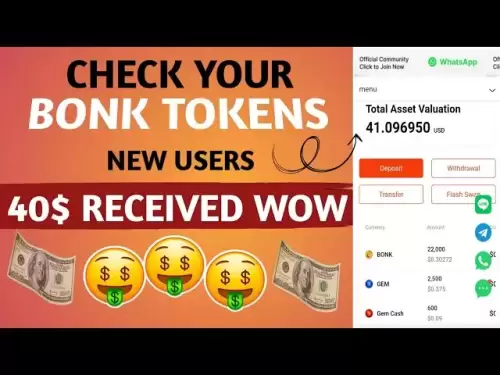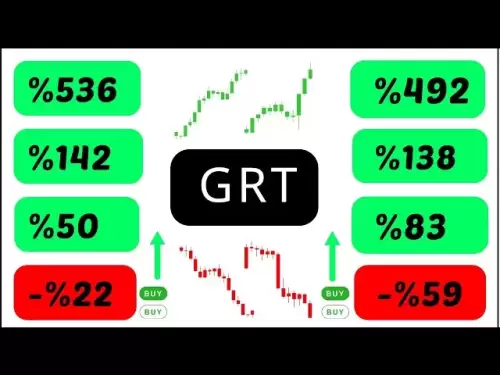-
 Bitcoin
Bitcoin $107,569.2021
1.41% -
 Ethereum
Ethereum $2,430.6950
-0.48% -
 Tether USDt
Tether USDt $1.0005
-0.01% -
 XRP
XRP $2.1884
-0.91% -
 BNB
BNB $647.4445
0.53% -
 Solana
Solana $144.2325
-0.49% -
 USDC
USDC $1.0000
-0.02% -
 TRON
TRON $0.2731
-0.48% -
 Dogecoin
Dogecoin $0.1658
0.61% -
 Cardano
Cardano $0.5694
-2.94% -
 Hyperliquid
Hyperliquid $37.2814
-0.09% -
 Bitcoin Cash
Bitcoin Cash $487.9461
7.41% -
 Sui
Sui $2.7788
-0.50% -
 Chainlink
Chainlink $13.2000
-1.28% -
 UNUS SED LEO
UNUS SED LEO $8.9994
0.22% -
 Stellar
Stellar $0.2417
-2.68% -
 Avalanche
Avalanche $17.6551
-2.73% -
 Toncoin
Toncoin $2.8498
-1.64% -
 Shiba Inu
Shiba Inu $0.0...01166
0.35% -
 Litecoin
Litecoin $84.6510
-0.54% -
 Hedera
Hedera $0.1507
-2.44% -
 Monero
Monero $315.5116
-0.39% -
 Ethena USDe
Ethena USDe $1.0001
-0.04% -
 Polkadot
Polkadot $3.3900
-1.91% -
 Dai
Dai $0.9999
0.00% -
 Bitget Token
Bitget Token $4.4262
3.03% -
 Pi
Pi $0.6122
12.98% -
 Uniswap
Uniswap $7.0039
-0.60% -
 Pepe
Pepe $0.0...09582
-3.75% -
 Aave
Aave $257.8121
-2.70%
How to store IMX safely? How to avoid asset loss when trading?
Securely store IMX using cold wallets like Ledger for long-term safety, and hot wallets like MetaMask for trading, always enabling 2FA and using strong passwords.
May 06, 2025 at 02:08 pm

Introduction to IMX and Its Importance
IMX, or Immutable X, is a layer-2 scaling solution for Ethereum that aims to provide instant trade confirmation, zero gas fees, and scalability for non-fungible tokens (NFTs). Given its rising popularity and utility in the crypto space, it's essential to store IMX securely and to understand how to avoid asset loss when trading. This article will guide you through the best practices for securely storing IMX and the steps you can take to minimize the risk of asset loss during trading.
Choosing the Right Wallet for Storing IMX
The first step in safely storing IMX is selecting an appropriate wallet. Wallets can be categorized into hot wallets and cold wallets. Hot wallets are connected to the internet and are suitable for frequent transactions, while cold wallets are offline and provide a higher level of security for long-term storage.
Hot Wallets: Examples include MetaMask, Trust Wallet, and Coinbase Wallet. These are convenient for trading and daily use. To set up a hot wallet for IMX, follow these steps:
- Download the wallet app or extension.
- Create a new wallet or import an existing one.
- Ensure the wallet supports IMX and add the token to your wallet if necessary.
- Always enable two-factor authentication (2FA) for an added layer of security.
Cold Wallets: Examples include Ledger and Trezor hardware wallets. These are ideal for storing larger amounts of IMX securely. Here's how to set up a cold wallet:
- Purchase a hardware wallet from the official website.
- Follow the manufacturer's instructions to set up the device.
- Create a new wallet or restore from a recovery seed.
- Transfer your IMX to the cold wallet address for secure storage.
Best Practices for Securing Your IMX Wallet
Once you have chosen your wallet, implementing security measures is crucial to protect your IMX. Here are some best practices:
Use Strong Passwords: Always use a strong, unique password for your wallet. Avoid using easily guessable information such as birthdays or simple phrases.
Enable Two-Factor Authentication (2FA): This adds an additional layer of security by requiring a second form of verification when logging in.
Backup Your Recovery Phrase: Write down your recovery phrase and store it in a secure location. Never share it with anyone or store it digitally.
Regular Software Updates: Keep your wallet software up to date to protect against known vulnerabilities.
Beware of Phishing Attempts: Always verify the authenticity of websites and emails. Do not click on suspicious links or enter your private keys on unknown sites.
Safeguarding IMX During Trading
Trading IMX can be profitable but also comes with risks. Here are steps to minimize the chance of asset loss during trading:
Use Reputable Exchanges: Only trade on well-known and reputable exchanges that have a track record of security and reliability. Research the exchange's security measures before trading.
Enable Withdrawal Whitelisting: Some exchanges allow you to whitelist addresses for withdrawals, ensuring that your IMX can only be sent to pre-approved addresses.
Use Limit Orders: Instead of market orders, use limit orders to control the price at which you buy or sell IMX, reducing the risk of slippage.
Monitor Your Transactions: Regularly check your transaction history and account balances to detect any unauthorized activity quickly.
Avoid Overleveraging: Be cautious with margin trading and avoid overleveraging, as this can lead to significant losses.
Handling IMX Transfers and Withdrawals
Transferring and withdrawing IMX requires careful attention to detail to avoid errors. Here's how to handle these operations safely:
Double-Check Addresses: Always verify the recipient's address before sending IMX. A single incorrect character can result in the loss of your assets.
Test Small Amounts First: Before sending large amounts of IMX, send a small test transaction to ensure the address is correct and the transaction goes through successfully.
Understand Transaction Fees: Be aware of the network fees associated with transferring IMX. Ensure you have enough ETH for gas fees on the Ethereum network.
Use Secure Networks: Avoid using public Wi-Fi when conducting transactions. Use a secure, private internet connection to minimize the risk of interception.
Protecting Against Scams and Fraud
The crypto space is rife with scams and fraud, and IMX holders are not immune. Here are some tips to protect yourself:
Research Before Investing: Thoroughly research any project or token before investing. Look for red flags such as anonymous teams or unrealistic promises.
Avoid Unsolicited Offers: Be wary of unsolicited offers, especially those promising high returns. These are often scams designed to steal your assets.
Use Official Channels: Only use official websites and communication channels for information and transactions. Verify the legitimacy of any platform or app before use.
Report Suspicious Activity: If you encounter a potential scam, report it to the relevant authorities and the platform where it occurred.
Frequently Asked Questions
Q: Can I store IMX on an exchange?
A: Yes, you can store IMX on an exchange, but it's generally less secure than using a personal wallet. If you choose to store IMX on an exchange, ensure it's a reputable one and consider enabling additional security features like withdrawal whitelisting.
Q: What should I do if I lose access to my IMX wallet?
A: If you lose access to your wallet, use your recovery phrase to restore it. If you don't have the recovery phrase, your IMX may be permanently lost. Always keep your recovery phrase in a secure location.
Q: How can I recover IMX sent to the wrong address?
A: Unfortunately, transactions on the blockchain are irreversible. If you send IMX to the wrong address, it is usually impossible to recover. Always double-check addresses before sending.
Q: Is it safe to use a mobile wallet for storing IMX?
A: Mobile wallets can be safe if you follow security best practices such as enabling 2FA, using strong passwords, and downloading the app from official sources. However, they are less secure than hardware wallets due to their internet connectivity.
Disclaimer:info@kdj.com
The information provided is not trading advice. kdj.com does not assume any responsibility for any investments made based on the information provided in this article. Cryptocurrencies are highly volatile and it is highly recommended that you invest with caution after thorough research!
If you believe that the content used on this website infringes your copyright, please contact us immediately (info@kdj.com) and we will delete it promptly.
- Bitcoin, Dogecoin, Ethereum: Decoding the Crypto Buzz
- 2025-06-26 04:25:12
- Jupiter (JUP) Price: Downtrend in Danger? Trend Shift Watch!
- 2025-06-26 04:25:12
- Dogecoin Price Prediction: Crypto Analyst Eyes $1 Target – Is the Meme Coin Ready to Rally?
- 2025-06-26 04:45:12
- Coinbase, Shares, and Stablecoins: Riding the Crypto Wave
- 2025-06-26 04:30:12
- Tether, Bitcoin, and Crypto Funds: A New York Minute on the Latest Moves
- 2025-06-26 05:25:12
- Bitcoin Price: Is a Drop Incoming? Analyzing the Latest Predictions
- 2025-06-26 05:25:12
Related knowledge

How to customize USDT TRC20 mining fees? Flexible adjustment tutorial
Jun 13,2025 at 01:42am
Understanding USDT TRC20 Mining FeesMining fees on the TRON (TRC20) network are essential for processing transactions. Unlike Bitcoin or Ethereum, where miners directly validate transactions, TRON uses a delegated proof-of-stake (DPoS) mechanism. However, users still need to pay bandwidth and energy fees, which are collectively referred to as 'mining fe...

USDT TRC20 transaction is stuck? Solution summary
Jun 14,2025 at 11:15pm
Understanding USDT TRC20 TransactionsWhen users mention that a USDT TRC20 transaction is stuck, they typically refer to a situation where the transfer of Tether (USDT) on the TRON blockchain has not been confirmed for an extended period. This issue may arise due to various reasons such as network congestion, insufficient transaction fees, or wallet-rela...

How to cancel USDT TRC20 unconfirmed transactions? Operation guide
Jun 13,2025 at 11:01pm
Understanding USDT TRC20 Unconfirmed TransactionsWhen dealing with USDT TRC20 transactions, it’s crucial to understand what an unconfirmed transaction means. An unconfirmed transaction is one that has been broadcasted to the blockchain network but hasn’t yet been included in a block. This typically occurs due to low transaction fees or network congestio...

How to check USDT TRC20 balance? Introduction to multiple query methods
Jun 21,2025 at 02:42am
Understanding USDT TRC20 and Its ImportanceUSDT (Tether) is one of the most widely used stablecoins in the cryptocurrency market. It exists on multiple blockchain networks, including TRC20, which operates on the Tron (TRX) network. Checking your USDT TRC20 balance accurately is crucial for users who hold or transact with this asset. Whether you're sendi...

What to do if USDT TRC20 transfers are congested? Speed up trading skills
Jun 13,2025 at 09:56am
Understanding USDT TRC20 Transfer CongestionWhen transferring USDT TRC20, users may occasionally experience delays or congestion. This typically occurs due to network overload on the TRON blockchain, which hosts the TRC20 version of Tether. Unlike the ERC20 variant (which runs on Ethereum), TRC20 transactions are generally faster and cheaper, but during...

The relationship between USDT TRC20 and TRON chain: technical background analysis
Jun 12,2025 at 01:28pm
What is USDT TRC20?USDT TRC20 refers to the Tether (USDT) token issued on the TRON blockchain using the TRC-20 standard. Unlike the more commonly known ERC-20 version of USDT (which runs on Ethereum), the TRC-20 variant leverages the TRON network's infrastructure for faster and cheaper transactions. The emergence of this version came as part of Tether’s...

How to customize USDT TRC20 mining fees? Flexible adjustment tutorial
Jun 13,2025 at 01:42am
Understanding USDT TRC20 Mining FeesMining fees on the TRON (TRC20) network are essential for processing transactions. Unlike Bitcoin or Ethereum, where miners directly validate transactions, TRON uses a delegated proof-of-stake (DPoS) mechanism. However, users still need to pay bandwidth and energy fees, which are collectively referred to as 'mining fe...

USDT TRC20 transaction is stuck? Solution summary
Jun 14,2025 at 11:15pm
Understanding USDT TRC20 TransactionsWhen users mention that a USDT TRC20 transaction is stuck, they typically refer to a situation where the transfer of Tether (USDT) on the TRON blockchain has not been confirmed for an extended period. This issue may arise due to various reasons such as network congestion, insufficient transaction fees, or wallet-rela...

How to cancel USDT TRC20 unconfirmed transactions? Operation guide
Jun 13,2025 at 11:01pm
Understanding USDT TRC20 Unconfirmed TransactionsWhen dealing with USDT TRC20 transactions, it’s crucial to understand what an unconfirmed transaction means. An unconfirmed transaction is one that has been broadcasted to the blockchain network but hasn’t yet been included in a block. This typically occurs due to low transaction fees or network congestio...

How to check USDT TRC20 balance? Introduction to multiple query methods
Jun 21,2025 at 02:42am
Understanding USDT TRC20 and Its ImportanceUSDT (Tether) is one of the most widely used stablecoins in the cryptocurrency market. It exists on multiple blockchain networks, including TRC20, which operates on the Tron (TRX) network. Checking your USDT TRC20 balance accurately is crucial for users who hold or transact with this asset. Whether you're sendi...

What to do if USDT TRC20 transfers are congested? Speed up trading skills
Jun 13,2025 at 09:56am
Understanding USDT TRC20 Transfer CongestionWhen transferring USDT TRC20, users may occasionally experience delays or congestion. This typically occurs due to network overload on the TRON blockchain, which hosts the TRC20 version of Tether. Unlike the ERC20 variant (which runs on Ethereum), TRC20 transactions are generally faster and cheaper, but during...

The relationship between USDT TRC20 and TRON chain: technical background analysis
Jun 12,2025 at 01:28pm
What is USDT TRC20?USDT TRC20 refers to the Tether (USDT) token issued on the TRON blockchain using the TRC-20 standard. Unlike the more commonly known ERC-20 version of USDT (which runs on Ethereum), the TRC-20 variant leverages the TRON network's infrastructure for faster and cheaper transactions. The emergence of this version came as part of Tether’s...
See all articles
























































































